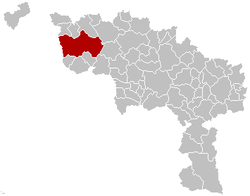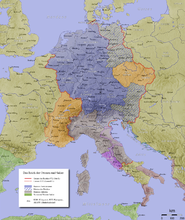- Tournai
-
Tournai Tournai Cathedral 
Flag
Coat of armsLocation in Belgium Coordinates: 50°36′N 3°23′E / 50.6°N 3.383°E Country Belgium Region Wallonia Community French Community Province Hainaut Arrondissement Tournai Government – Mayor Christian Massy (PS) – Governing party/ies PS-cdH Area – Total 213.75 km2 (82.5 sq mi) Population (1 January 2010)[1] – Total 69,043 – Density 323/km2 (836.6/sq mi) Postal codes 7500-7548 Area codes 069 Website www.tournai.be Tournai (French pronunciation: [tuʁnɛ], in Dutch Doornik, in Latin: Tornacum) is a Walloon city and municipality of Belgium located 85 kilometres southwest of Brussels, on the river Scheldt, in the province of Hainaut.
Along with Tongeren, Tournai is the oldest city in Belgium and it has played an important role in the country's cultural history.
Contents
Geography
Tournai is located in the lowlands of Belgium, at the southern limit of the Flemish plain, in the basin of the river Escaut ("Schelde" in Dutch). Administratively, the town is part of the Province of Hainaut, itself part of Wallonia. It is also a municipality that is part of the French-speaking Community of Belgium. Tournai has its own arrondissements, both administrative and judicial.
Its area of 213.75 km² makes it the largest commune in size in Belgium; it is also the largest in population in Western Hainaut. The municipality of Tournai consists of the former municipalities of Ere, Saint-Maur, Orcq, Esplechin, Froyennes, Froidmont, Willemeau, Ramegnies-Chin, Templeuve, Chercq, Blandain, Hertain, Lamain, Marquain, Gaurain-Ramecroix, Havinnes, Beclers, Thimougies, Barry, Maulde, Vaulx, Vezon, Kain, Melles, Quartes, Rumillies, Mont-Saint-Aubert, Mourcourt and Warchin.
Geology
Rocks from the Tournai area date from the Carboniferous Period and have been used to define the Tournaisian Age, a subdivision of the Carboniferous lasting from 359 to 345 million years ago. Tournai stone is a dark limestone which takes a polish and was used particularly in the Romanesque period for sculpted items such as baptismal fonts. It is also hard enough to have been used locally for pavements and kerb-stones. It is sometimes called Tournai marble, though this is geologically inaccurate.
History
Tournai, known as Tornacum, was a place of minor importance in Roman times, a stopping place where the Roman road from Cologne on the Rhine to Boulogne on the coast crossed the river Scheldt. It was fortified under Maximian in the third century,[2] when the Roman limes was withdrawn to the string of outposts along the road. It came into the possession of the Salian Franks in 432. Under king Childeric I, who was buried or reburied there,[3] Tournai was the capital of the Frankish empire. In 486, Clovis moved the center of power to Paris. In turn, a native son of Tournai, Eleutherius, became bishop of the newly created bishopric of Tournai, extending over most of the area west of the Scheldt. In 862 Charles the Bald, first king of Western Francia and still to become Holy Roman Emperor, would make Tournai the seat of the County of Flanders.
After the partition of the Frankish empire by the Treaties of Verdun (843) and of Meerssen (870), Tournai remained in the western part of the empire, which in 987 became France. The city participated in eleventh-century rise of towns in the Low Countries, with a woollen cloth industry based on English wool, which soon made it attractive to wealthy merchants. An ambitious rebuilding of the cathedral was initiated in 1030. The commune's drive for independence from the local counts succeeded in 1187, and the city was henceforth directly subordinated to the French Crown, as the seigneurie de Tournaisis, as the city's environs are called. The stone Pont des Trous over the Scheldt, with defensive towers at either end, was built in 1290, replacing an earlier wooden structure.
During the 15th century, the city's textile trade boomed and it became an important supplier of tapestry. The art of painting flourished too: Jacques Daret, Robert Campin and Rogier van der Weyden all came from Tournai. It was conquered in 1513 by Henry VIII of England, making it the only Belgian city ever to have been ruled by England. It was also represented in the 1515 Parliament of England. The city was handed back to French rule in 1519.
In 1521, Emperor Charles V added the city to his possessions in the Low Countries, leading to a period of religious strife and economic decline. During the 16th century, Tournai was a bulwark of Calvinism, but eventually it was conquered by the Spanish governor of the Low Countries, the Duke of Parma, following a prolonged siege in 1581. After the fall of the city, its Protestant inhabitants were given one year to sell their possessions and emigrate, a policy that was at the time considered relatively humane, since very often religious opponents were simply massacred.
One century later, in 1668, the city briefly returned to France under Louis XIV in the Treaty of Aachen. After the end of the War of Spanish Succession in 1713, under terms of the Treaty of Utrecht the former Spanish Netherlands, including Tournai, came into possession of the Austrian Habsburgs. From 1815 on, following the Napoleonic Wars, Tournai formed part of the United Netherlands and after 1830 of newly independent Belgium. Badly damaged in 1940, Tournai has since been carefully restored.
 "Pont des Trous" bridge on the Scheldt river with Our Lady of Flanders' Cathedral of Tournai in the distance
"Pont des Trous" bridge on the Scheldt river with Our Lady of Flanders' Cathedral of Tournai in the distance
Main sights
Tournai is considered to be one of the most important cultural sites in Belgium. The mixed Romanesque- and Gothic-style cathedral of Notre Dame de Tournai and the belfry, the oldest in Belgium, have been jointly designated by UNESCO as a World Heritage Site. Inside the cathedral, the Châsse de Notre-Dame flamande, a beautifully ornate 12th-century reliquary, gives witness to Tournai's wealth in the Middle Ages. Other places of interest are the 13th-century Scheldt bridge (Pont-des-Trous) and the main square (Grand'Place), as well as several old city gates, historic warehouses, and a variety of museums.
On rue Barre-St-Brice are two of the oldest private houses in Europe, dating from between 1175 and 1200 and built in the Romanesque style, while the rue des Jésuites includes a Gothic house from the 13th century.
As is the case with many cities in Belgium there are a number of beautiful and friendly cafés and pubs in the Grand'Place. In the middle of the Grand'Place there are a series of water fountains that are fun to observe and even play in for people of all ages. Another great interactive experience available is climbing the circular staircase to the top of the belfry.
There are several buildings in the art nouveau style.
Culture
A French-speaking Flemish town
Tournai is a French-speaking town of Belgium. The local language is tournaisien, a Picard dialect similar to that of other communes of Hainaut and Northern France.
Tournai belongs to Romance Flanders, like Lille, Douai, Tourcoing, and Mouscron. The city of Tournai was one of the greatest cultural and economic centers of the County of Flanders. Some traces can still be seen today:
- The gothic choir of Our Lady's Cathedral is a precursory element of the Scaldian (meaning from the Scheldt area), typically Flemish, Gothic art.
- The bishopric of Tournai was the religious capital of Flanders during more than a millennium (from 496 to 1559).
- The tapestries and draperies of Tournai belong to the great Flemish school of tapestry and Tournai was part of the Flemish Hansa of London, which also included the draper towns of Flanders.
- The Saint-Brice church of Tournai, dedicated to Saint Britius, is one of the first examples of the hallekerk style, so typical of the Flemish countryside.
- Some of the great Flemish Primitives are from Tournai: Robert Campin, Roger van der Weyden, Jacques Daret.
Although Tournai is in the Flemish cultural area (of the Scheldt), it also possesses some treasures of the Mosan style. Indeed, the two most beautiful shrines of the Cathedral, commissioned by the Bishop of Tournai, were made in the region of Liège by the artist Nicholas of Verdun: the shrines of Saint-Eleutherius and of Our Lady of Flanders (13th century). Those shrines testify to the opulence of the towns of Tournai and Liège during the Middle-Ages. The shrine of Our Lady of Flanders has been called one of the seven wonders of Belgium.
Festivities
- The "Great Procession" (in French: Grande Procession) has taken place every year since 1092, with the single exception of the year 1566, when the iconoclasts considerably damaged the religious symbols of the city. This historic procession unfolds in the streets every second Sunday of September.
- The first Monday after January 6 is known as "Lost Monday" (in French: Lundi perdu) or "Perjury Monday" (Lundi parjuré). This tradition dates from more than 700 years ago. The wealthier city inhabitants used to prepare fastuous family dinners and elect a king. Today, the family dinners have expanded to wider groups and a rabbit dish is often served.
People born in Tournai
- Clovis I, first king of all Salian Franks
- Gilles Li Muisis, French chronicler and poet (13th century)
- Roger van der Weyden, Flemish painter (15th century)
- Jacques Daret, Flemish painter (15th century)
- Pierre de La Rue, Franco-Flemish composer (15th century)
- Perkin Warbeck, impostor and pretender to the throne of England (15th century)
- Marbrianus de Orto, Franco-Flemish composer (15th-16th century)
- Charles Blount, 5th Baron Mountjoy, courtier and patron of learning (16th century)
- Isaac Le Maire, pioneering merchant of the VOC, the Dutch East India Company (16th century)
- Louise-Françoise de Bourbon (1673–1743) illegitimate daughter of Louis XIV of France and his most famous mistress Madame de Montespan.
- Donat Casterman, publisher (18th century)
- Piat Sauvage, painter (19th century)
- Louis Gallait, painter (19th century)
- Jean-Baptiste Moëns, philatelist (19th century)
- Jules Bara, statesman (19th century)
- Georges Rodenbach, Symbolist poet and novelist (19th century)
- Hélène Dutrieu, cycle racer, stunt driver and aviator (19th and 20th centuries)
- Marc Quaghebeur, writer (20th century)
- Xaveer De Geyter, architect (20th century)
See also
Gallery
-
The cathedral of Notre Dame de Tournai
Twin towns
 Troyes, France
Troyes, France Villeneuve-d'Ascq, France
Villeneuve-d'Ascq, France
References
- ^ Population per municipality on 1 January 2010 (XLS; 221 KB)
- ^ Williams, Stephen. Diocletian and the Roman Recovery. New York: Routledge, 1997:50f.
- ^ His tomb was rediscovered in 1655.
External links
- Internationale petitie tegen het bouwproject van een toren in de Unesco zone van de kathedraal van Doornik (België).
- UNESCO World Heritage Site Citation
- Official site — The city's site, available in French, English and Dutch.
- Tournai City.net — Online directory for this city.
- Joan of Arc's letter to Tournai — English translation (by Allen Williamson) of this letter dictated by Joan of Arc on June 25, 1429.
- Apis Tornacensis — database and bibliography about history.
- Medieval Tournai An Academic Resource Center
- Société Royale d'Histoire et d'Archéologie de Tournai, an exhaustive list of references on the history of the Tournai region, in French.
Ath 
Charleroi Mons Mouscron Soignies Thuin Anderlues · Beaumont · Binche · Chimay · Erquelinnes · Estinnes · Froidchapelle · Ham-sur-Heure-Nalinnes · Lobbes · Merbes-le-Château · Momignies · Morlanwelz · Sivry-Rance · ThuinTournai Antoing · Brunehaut · Celles · Estaimpuis · Leuze-en-Hainaut · Mont-de-l'Enclus · Pecq · Péruwelz · Rumes · TournaiCategories:- Populated places in Belgium
- Municipalities of Hainaut
- Romanesque architecture in Belgium
- World Heritage Sites in Belgium
Wikimedia Foundation. 2010.





















